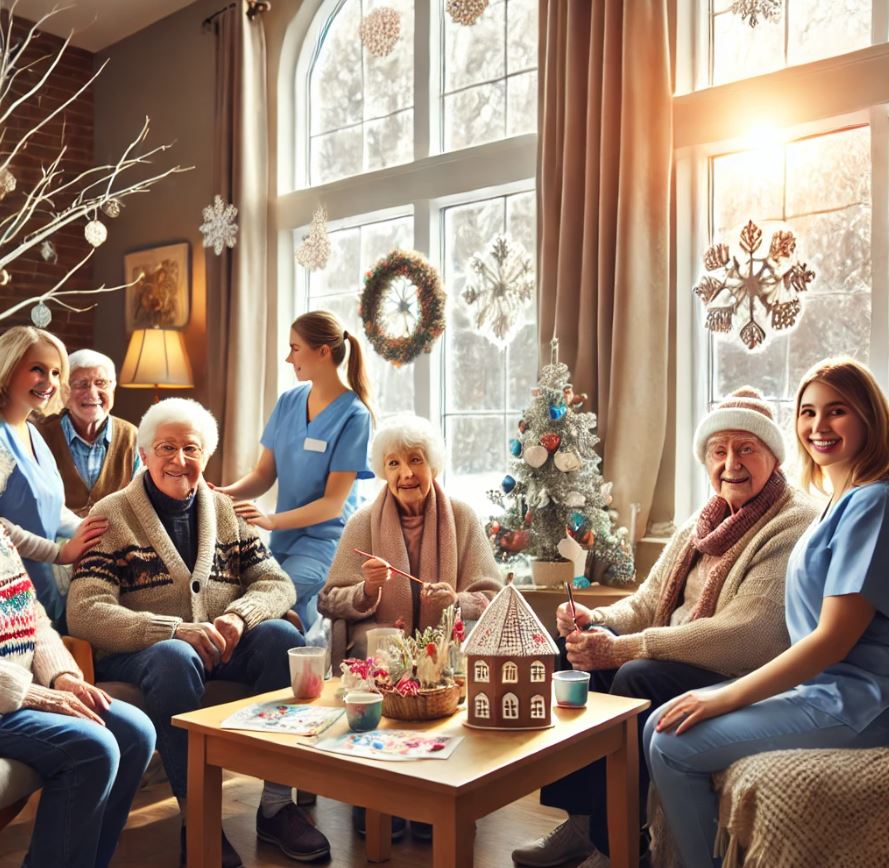Seasonal Affective Disorder (SAD), commonly known as seasonal depression, is a form of depression that occurs at certain times of the year, usually during the fall and winter months when daylight hours are shorter. This condition can affect anyone, but seniors, particularly those in assisted living homes, may be especially vulnerable due to reduced outdoor activity, changes in routine, and the natural aging process. For these residents, feelings of sadness, fatigue, or hopelessness can be intensified during colder months, leading to a decline in mental and physical well-being.
Recognizing the signs of seasonal depression and implementing strategies to support residents is crucial for assisted living homes. By creating a caring, supportive, and engaging environment, these homes can help residents cope with seasonal depression and enhance their quality of life.
1. Understanding Seasonal Depression and Its Impact on Seniors
Seasonal Affective Disorder is believed to be linked to the reduced exposure to sunlight during the fall and winter. Less daylight affects the body’s circadian rhythm, which can disrupt sleep patterns and reduce serotonin levels, a chemical that influences mood. These changes can lead to symptoms such as:
– Persistent sadness or low mood
– Fatigue and low energy
– Difficulty concentrating
– Changes in sleep patterns (sleeping too much or too little)
– Loss of interest in activities once enjoyed
– Social withdrawal
– Increased feelings of loneliness
For seniors in assisted living, these symptoms can be particularly challenging. Many older adults already face changes in their physical health, mobility, and social relationships, and the added impact of seasonal depression can exacerbate feelings of isolation and helplessness.
2. Recognizing the Signs of Seasonal Depression in Residents
Assisted living staff play a critical role in identifying the signs of seasonal depression among residents. Since seniors may not always express their feelings openly or recognize the symptoms themselves, caregivers need to be attentive to changes in behavior, mood, or routine.
Some signs that a resident may be experiencing seasonal depression include:
– Withdrawal from social activities and interactions
– Changes in appetite or sleep patterns
– Increased irritability or mood swings
– Lack of enthusiasm for hobbies or daily routines
– Complaints of persistent fatigue or feeling “down”
Early identification of these symptoms is key to providing timely support and interventions that can help prevent the condition from worsening.
3. How Assisted Living Homes Can Help Residents Cope with Seasonal Depression
There are several ways that assisted living homes can help residents manage the effects of seasonal depression. By fostering a supportive and stimulating environment, caregivers can mitigate the impact of reduced sunlight and help residents maintain a positive outlook during the winter months.
a. Maximizing Exposure to Natural Light
One of the most effective ways to combat seasonal depression is by increasing exposure to natural light. Assisted living homes can take several steps to ensure that residents receive adequate daylight, including:
– Encouraging Outdoor Time: Even in the colder months, spending time outside during daylight hours can be beneficial. Assisted living homes can organize outdoor activities like short walks, patio visits, or simply sitting outside with a blanket. These moments of sunlight can help regulate circadian rhythms and improve mood.
– Bringing Natural Light Indoors: In rooms and common areas, ensure that windows are uncovered to let in as much natural light as possible. Positioning seating areas near windows can encourage residents to enjoy the sunlight. Skylights and large windows in shared spaces can also increase exposure to daylight.
– Light Therapy: Some assisted living homes may consider using light therapy lamps, which mimic natural sunlight and can be helpful for residents struggling with seasonal depression. These lamps can be set up in common areas, encouraging residents to sit near them while reading or engaging in activities.
b. Maintaining a Regular Routine and Physical Activity
Daily routines provide structure and stability, which is crucial for seniors’ mental health. During the winter months, it’s important to maintain regular schedules, particularly for activities, meals, and exercise.
– Exercise Programs: Physical activity is a natural mood booster and helps combat feelings of lethargy. Assisted living homes can offer regular exercise classes, such as chair yoga, stretching, or low-impact aerobics, to help residents stay active. Even indoor walking groups or dancing can help improve energy levels and reduce symptoms of depression.
– Daily Routines: Keeping residents engaged in regular, predictable routines, including meals, activities, and social interactions, can reduce the likelihood of depressive episodes. Routines help give structure to the day, ensuring that residents don’t feel lost or unmotivated.
c. Encouraging Socialization and Interaction
Social isolation can worsen the symptoms of seasonal depression, so maintaining social connections is essential for residents’ emotional health. Assisted living homes can create opportunities for residents to interact with each other, staff, and their families.
– Group Activities and Events: Assisted living homes can host group activities such as movie nights, craft sessions, book clubs, or game afternoons that foster social interaction. Group activities encourage residents to stay engaged and connected with their peers.
– One-on-One Time: Caregivers can make an effort to spend extra one-on-one time with residents who may be more prone to seasonal depression. Whether it’s having a casual conversation, assisting with a hobby, or simply offering companionship, these personal interactions can make a significant difference in a resident’s mood.
– Family Visits and Virtual Connections: Encouraging family visits, especially during the holiday season, helps residents feel supported and loved. For families who cannot visit in person, virtual visits through video calls can still provide meaningful connection and reassurance.
d. Promoting Mental and Emotional Wellness
Caring for residents’ mental health during the winter months is crucial for preventing seasonal depression from taking hold. Assisted living homes can offer a range of mental health services and emotional support to ensure residents feel cared for and heard.
– Mental Health Support: Access to mental health professionals, such as counselors or therapists, can provide residents with a safe space to talk about their feelings and receive professional guidance. This support is especially important for residents who may be more vulnerable to depression or anxiety.
– Mindfulness and Relaxation: Activities like meditation, breathing exercises, or guided relaxation can help residents manage stress and anxiety. These practices can be incorporated into the daily routine to create moments of calm and emotional relief.
– Creative Expression: Offering opportunities for residents to express themselves through art, music, or writing can also help combat seasonal depression. Creative outlets provide a sense of accomplishment and joy, while also allowing residents to process their emotions in a constructive way.
e. Creating a Warm and Inviting Environment
The physical environment of the assisted living home plays an important role in residents’ emotional well-being. During the colder months, creating a warm, cozy atmosphere can help lift spirits and promote a sense of comfort.
– Seasonal Decorations: Changing the décor to reflect the seasons can create a positive, festive atmosphere. Incorporating elements like warm lighting, seasonal flowers, or holiday decorations can make the space feel cheerful and inviting.
– Cozy Communal Spaces: Ensuring that communal spaces are warm, comfortable, and well-lit encourages residents to spend time outside their rooms. A cozy reading corner, a fireplace, or soft blankets can make shared spaces more appealing during winter months.
4. Educating Staff and Residents on Seasonal Depression
An important step in combating seasonal depression in assisted living homes is ensuring that both staff and residents are aware of the condition and its effects. Educating staff on the signs of seasonal depression and how to address it ensures that they can provide appropriate support to residents.
– Staff Training: Caregivers should be trained to recognize the early signs of seasonal depression and know how to respond. This can include being vigilant for changes in behavior, mood, or activity levels and knowing when to seek professional help for a resident.
– Resident Awareness: Residents themselves can benefit from learning about seasonal depression. Group discussions or educational workshops can help them understand the condition, recognize symptoms in themselves, and explore coping strategies.
Shepherd Premier Senior Living understands that seasonal depression can significantly impact the well-being of residents, but with the right strategies and support, its effects can be mitigated. By maximizing natural light, maintaining routines, encouraging socialization, promoting emotional wellness, and creating a warm, inviting environment, we can help residents navigate the challenges of seasonal depression. Through compassionate care and a proactive approach, we can ensure that residents feel supported, connected, and engaged throughout the year, no matter the season.
If you think Shepherd Premier might be a good fit for you, contact us today.


